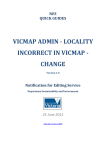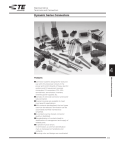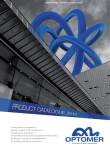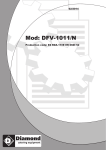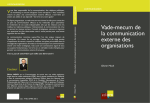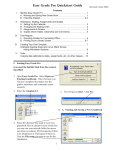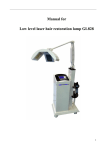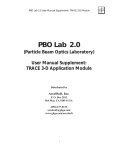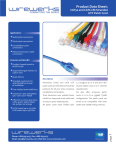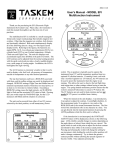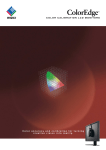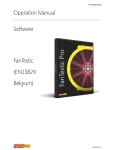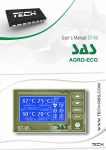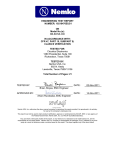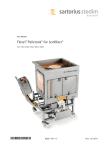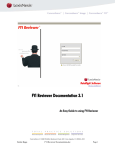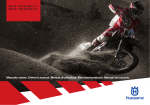Download Room-Temperature Test Of Caging System In
Transcript
P0536 Rev. A September 11, 2000 STANFORD UNIVERSITY W.W. HANSEN EXPERIMENTAL PHYSICS LABORATORY GRAVITY PROBE B, RELATIVITY GYROSCOPE EXPERIMENT STANFORD, CALIFORNIA 94305-4085 ROOM-TEMPERATURE TEST OF CAGING SYSTEM IN PROBE C GP-B SCIENCE MISSION PROCEDURE P0536 Rev-A September 11, 2000 PREPARED _______________________________________ R. Brumley, Gyroscope RE _________________ Date APPROVED _______________________________________ J. Mester, Caging System RE _________________ Date APPROVED _______________________________________ C. Gray, Gyroscope Verification _________________ Date APPROVED _______________________________________ D. Ross, Quality Assurance and Safety _________________ Date APPROVED _______________________________________ B. Muhlfelder, Technical Manager _________________ Date 1 P0536 Rev. A September 11, 2000 REVISION HISTORY Rev Date - 07/11/99 A 09/11/00 Comments Change procedure to incorporate minor redlines from the previous run. Main structure of the procedure has not been changed. 2 P0536 Rev. A September 11, 2000 1. SCOPE This procedure is intended to be used to verify the functionality of the caging system as part of the room-temperature checkout of Probe C prior to the cryogenic acceptance testing. It may be used at other stages of probe acceptance testing if so desired. This procedure is only intended to verify basic functionality of the system (i.e. that the gyroscope cages and uncages). It does not seek to measure any basic parameters of the caging process. Note that the DDC must be installed per procedure P0481 before performing this procedure. 2. REFERENCES 2.1 Plans and Procedures P0481 Levitation of Gyroscopes in Probe C P0505 RT Spinup of Gyroscopes in Probe C P0410 Pumpdown and leak check 3. GENERAL REQUIREMENTS 3.1 Environmental Requirements 3.1.1 Cleanliness This procedure takes place in the Class 1000 cleanroom in the HEPL building. Minimum protective garments for personnel working in the clean rooms shall be the standard Tyvek clean room apparel. All activities taking place within this room must be in accordance with the guidelines established by the cleanroom manager. 3.1.2 Particulate Contamination All connectors shall be inspected and verified free of particulate contamination before they are mated to Probe C. It is also desirable to keep the probe in general clean and free of particulate contamination. Note: The caging lines have an I.D. of 5 milli-inches. It is therefore very easy to clog the lines should any contamination be present. Great care must be taken to ensure that no particles get into the caging lines. 3.1.3 Magnetic Contamination This procedure takes place after the vacuum can is sealed, making the experiment much less sensitive to magnetic contamination. However, great care shall still be taken to avoid cross contamination between any magnetic (e.g. steel) item and the 3 P0536 Rev. A September 11, 2000 probe, particularly on the probe's "cold" end. Therefore no magnetic items may be used in the immediate vicinity of the "cold" end of the probe. 3.2 Test Personnel 3.2.1 Test Director The test director for this procedure shall be Robert Brumley, or his appointed replacement. 3.2.2 Personnel The following personnel have received the training necessary to perform this procedure. • • • • • • David Hipkins Bruce Clarke Chris Gray Robert Brumley Dr. John Mester Dr. Sasha Buchman See section 3.4 for details on the requirements for Quality Assurance notification and witnessing of this procedure. 3.2.3 Minimum Personnel No activity shall be performed on the science mission probe without at least two people in the room, i.e. at least one person to perform the procedure and one person to observe the procedure. 3.3 Safety 3.3.1 Hardware Safety -- General It is important to be cognizant at all times of the position of the probe. Be extremely careful not to accidentally bump into the probe. If any connector does not connect smoothly and securely, do not try to force it. Instead, remove the connector and inspect it to find the reason for the difficulty. Great care must be taken at all times during the performance of this procedure. 3.3.2 Electrostatic Discharge Grounded wrist straps shall be worn at all times when mating or demating to an electrical connector on Probe C. 4 P0536 Rev. A September 11, 2000 3.3.3 Personnel Safety All operations shall take place according to Stanford University safety guidelines. Any person observing a situation which they deem unsafe shall report the fact immediately to the test director. The Quality Assurance representative shall be responsible for monitoring that all activities are performed in a safe manner. 3.4 Quality Assurance • Stanford QA must be notified at least 24 hours before beginning this procedure. • ONR QA must be notified at least 24 hours before beginning this procedure. • D. Ross (or her designate) must be present to monitor the completion of this procedure. This procedure shall be conducted on a formal basis to its latest approved and released version. The QA Program Engineer shall be notified of the start of this procedure. A Quality Assurance representative designated by D. Ross shall review any discrepancy noted during test. Redlines shall be approved by the QA representative. The QA representative will nominally be Russ Leese. Upon completion of this procedure, the QA Program Engineer, D. Ross or R. Leese, shall certify his or her concurrence that the effort was performed and accomplished in accordance with the prescribed instructions by signing and dating the appropriate approval line at the end of the procedure. 3.5 Red-Line Authority Authority to red-line (make minor chances during execution) this procedure is given to the qualified personnel listed in section 3.2.2. All redlines must be approved by the QA representative. In addition, approval by the Hardware Manager shall be required if, in the judgement of the test director or the QA representative, experiment functionality may be affected. 3.6 Electrical Connections When mating to any flight connector, the following items are required: • A grounded ESD strap must be worn by any person handling a connector on Probe C • Inspect both connectors being mated to ensure that there are no particles that might interfere with the mate. 5 P0536 Rev. A September 11, 2000 • Each mate and demate of flight connectors must be logged in that connector's mate/demate log sheet. Note that these log sheets have already been started for all suspension lines. 4. REQUIRED EQUIPMENT 4.1 Flight Hardware • 4.2 Probe C assembly with vacuum can installed, no sunshade. Ground Support Equipment The following equipment is necessary to perform these tests. Item Quantity GSE plumbing assembly for caging 1 Bottle of ultra-pure He 1 Gaskets for VCR fittings (connector savers for flight gammah connections) 3 Digital Multimeter capable of reading resistances >200 MΩ. 1 Model: __________________________________ S/N: ____________________________________ DDC-Probe C Interface Box 1 DDC Suspension System 4.3 1 / gyro testing Software No software is necessary for this procedure. 4.4 Tools and Miscellaneous Fluke meters and capacitance meters shall be readily available should the need to trouble shoot arise. 5. GUIDELINES FOR OPERATIONS 6 P0536 Rev. A September 11, 2000 • This procedure may be completed with the probe either at atmospheric pressure or in high vacuum. • This procedure should be completed for each gyroscope in the probe. • Note that the DDC must be installed per P0481 before performing this procedure. • Gyroscopes 1 and 2 can be tested separately • Note that the same line feeds both gyroscopes #3 and #4. Therefore both gyroscopes cage at the same time. However, there are two valves that feed this one line. Both of these valves need to be checked. • This procedure leaves the option for either a full cage (160 psi) or a partial cage "touch test" (~40 psi) 6. INITIAL SETUP 6.1 Enter the following data: Start Date: _____________________ Start Time: _____________________ Gyroscope(s) #: ___________________ Note: Gyroscopes 3 and 4 are automatically caged at the same time. 6.2 Assemble all equipment on the Equipment list in Section 4 6.3 Turn on and prepare the leak detector for test. This should be done in accordance with its user manual. 6.4 Purge the caging GSE for at least 5 minutes by opening V1, V2, V3, V5, V6 and the metering valve. V4 (the vent valve) should be closed. 6.5 Set the regulator on the He supply to 165 psid. Note: One should not exceed 185 psi on the caging assembly. Since the probe will be evacuated, 185 psi on the caging assembly = 185 – 14.7 ~ 170 psi on a gauge. Therefore the regulator on the He supply is set to 165 to provide some safety margin. 6.6 Close the regulator on the caging GSE enough so that a very light flow of He is still present. 6.7 Connect the GSE plumbing to probe C and the leak detector per Figure 1. Note that Figure 1 contains the proper valve designation. Record here: 7 P0536 Rev. A September 11, 2000 Line Designation = CG_____ 6.8 Set the valves to the following states: (Open means gas can flow through the valve, Closed means gas can not flow through the valve) V1 ⇐ Open _______ V2 ⇐ Open _______ V3 ⇐ Open _______ V4 ⇐ Closed _______ V5 ⇐ Open _______ V6 ⇐ Open _______ V7 ⇐ Open _______ V8 ⇐ Closed _______ Metering Valve ⇐ Closed _______ GSE regulator ⇐ Closed _______ Open at 165 psi _______ He bottle regulator ⇐ 6.9 Prepare to open the valve on the caging line of Probe C. 6.10 To be completed if caging lines are currently under vacuum Cycle the leak detector to test mode per the instructions in its user manual. Pump on the caging assembly until the base pressure goes below 10-3 torr. Open the relevant caging valve on the probe. Go to step 6.12 (skip 6.11) 6.11 To be completed if caging lines are currently at atmosphere Open the relevant caging valve on the probe. (Optional) It is now permitted to pump on the caging line and GSE with the leak detector. This step need only be performed if (a) there is a desire to leak check the portion of the caging lines outside the vacuum can, or (b) it is desired to eliminate any N2 in the lines prior to a cryogenic insertion. 8 P0536 Rev. A September 11, 2000 Check if line was pumped on: ______________ 6.12 OPTIONAL CHECK FOR CAGING LINE TO WELL LEAKS If the lines are being pumped on with the leak detector according to 6.10 or the optional component of 6.11, it is now possible to perform a leak check on the portions of the caging lines that are outside the vacuum can. Record Results in Table 1. Check if done: ____________________ 9 P0536 Rev. A September 11, 2000 TABLE 1 (OPTIONAL): CAGING LINE LEAKAGE RATE CHECK (Caging Line to Well Leaks) Caging Line CG_____________ Time Port Pressure He Rate Notes 10 P0536 Rev. A September 11, 2000 TABLE 1 (OPTIONAL): CAGING LINE LEAKAGE RATE CHECK (Caging Line to Well Leaks) Time Port Pressure He Rate Notes 11 P0536 Rev. A September 11, 2000 6.12 Isolate the leak detector by closing V7. 6.13 Vent the leak detector according the instructions in its user manual. 6.14 (Optional) Re-connect the leak detector to its test port on the pumping system (LTV). This allows a leak check of the portions of the caging lines which sit inside the vacuum can (by monitoring the rate of He rise in the can when the lines are pressurized for the cage). To do this, configure the system according to the instructions of P0410 Section 7. Check if done: ____________________ 6.15 The system is now ready to begin pressurization of the caging line. 7. GYROSCOPE CAGING VERIFICATION 7.1 Verify that the DDC is already connected to the probe. If not, connect per P0481 Section 6. 7.2 If not already done, connect the DDC - Probe C connector saver to the ground plane connection for the gyroscope of interest. For reference, these connections are: Gyroscope #1: CG18 Gyroscope #2: CG28 Gyroscope #3: CG38 Gyroscope #4: CG48 Note that static protection wrist bands must be worn during this procedure. 7.3 Connect the Electrometer to the ground plane connection per Figure 2. 7.4 Connect the other electrometer lead to probe ground (which should be identical to the potential of the caging fixture potential). 7.5 Record the initial (uncaged) position indicated on the DDC (microinches). Note that the second line is only to be used if caging two gyroscopes simultaneously (i.e. Gyros 3 and 4) X = _________ Y = _________ Z = _________ Gyro # ________ X = _________ Y = _________ Z = _________ Gyro # ________ 7.6 Verify that the valves are in the following state: V1 ⇐ Open _______ V2 ⇐ Open _______ 12 P0536 Rev. A September 11, 2000 V3 ⇐ Open _______ V4 ⇐ Closed _______ V5 ⇐ Open _______ V6 ⇐ Open _______ V7 ⇐ Closed _______ V8 ⇐ Closed _______ Metering Valve ⇐ Closed GSE regulator ⇐ Open at 160 psi (40 for partial cage) _______ He bottle regulator ⇐ Open at 165 psi (45 for partial cage) _______ Caging Valve on Probe ⇐ Already open _______ _______ 7.7 Open the metering valve slowly. 7.8 Gradually increase the pressure regulated by the caging GSE’s regulator until the gyroscope cages. Record the process in the following table. The gyroscope is caged when the resistance indicated on the ohmmeter goes from >1 GΩ to ~100 MΩ and when the rotor has stopped moving on the DDC position readout. 7.9 Close the metering valve and V3 7.10 Record the final (caged) position indicated on the DDC (microinches). Note that the second line is only to be used if caging two gyroscopes simultaneously (i.e. Gyros 3 and 4) X = _________ Y = _________ Z = _________ Gyro # ________ X = _________ Y = _________ Z = _________ Gyro # ________ 7.11 Venting Line to Atmosphere The gyroscope may be uncaged using this method if it is not being completed as the final operation on the caging line prior to insertion into the LT dewar. Otherwise use step 7.11 Vent the line by opening V4. Close V4 as soon as the high-pressure He has left the line. 7.12 Leaving Line in Vacuum This step leaves the line in vacuum. It should be performed whenever it 13 P0536 Rev. A September 11, 2000 is necessary to leave the line without any air in it (e.g. prior to lowtemperature insertion). Reconnect the leak detector to V7 and cycle the leak detector to test. As the space between the leak detector and V7 is being pumped down, open V7 to pump out the entire line. 7.12 Close the CG valve on the probe for the caging line being tested. 7.13 Record the final (uncaged) resistance: R = ____________________ 7.14 Record the final (uncaged) position below (the second line is to be used if two gyroscopes are being caged at once). X = _________ Y = _________ Z = _________ Gyro # ________ X = _________ Y = _________ Z = _________ Gyro # ________ 7.13 Remove the caging GSE from the probe. 7.14 Replace the cap on the valve of the caging line in the probe 14 P0536 Rev. A September 11, 2000 RECORD OF CAGING CHECK Gyroscope # ___________________ Pressure (psid) Resistance Caging Valve CG___________________ Gyroscope Position [X Y Z] microinches 15 Notes (e.g. Caging Leak Rate) P0536 Rev. A September 11, 2000 Output Pressure Transducer V4 Vent Caging Control Unit Valve V8 V7 V5 V3 Input Pressure Meter Leak Detector 300 cc ballast Regulated Pressure Meter V6 Metering Valve 0.5µ filter V1 Regulato GHe Supply Bottle Gyro 1 Lines Gyro 2 Lines CG5 CG6 CG4 Probe Top Hat Caging Valves -Y CG3 -X CG2 Manual Gamah CG1 Vacuum Compression Ring Connector Gyros 3&4 Lines Filter Caging GSE Plumbing Schematic - not to scale Figure 1: Caging Test Assembly clips Caging Assembly – Electrometer Plunger + Gyro Electrode ground plane Figure 2: Schematic for Ground Plane Resistance Check 16 V2 P0536 Rev. A September 11, 2000 8. PROCEDURE COMPLETION Record completion of this procedure in the traveler, as appropriate. Record any abnormalities or deviations from this procedure in the D-Log. If the QA representative decides it is appropriate, open a Discrepancy Report to document the event. This test has been completed according to the procedure contained herein. All redlines used have been integrated into this document. Test Director: (print) (optional) Test Engineer: (print) (optional) Test Engineer: (print) (sign) (sign) (sign) QA Representative: (print) (sign) 17


















